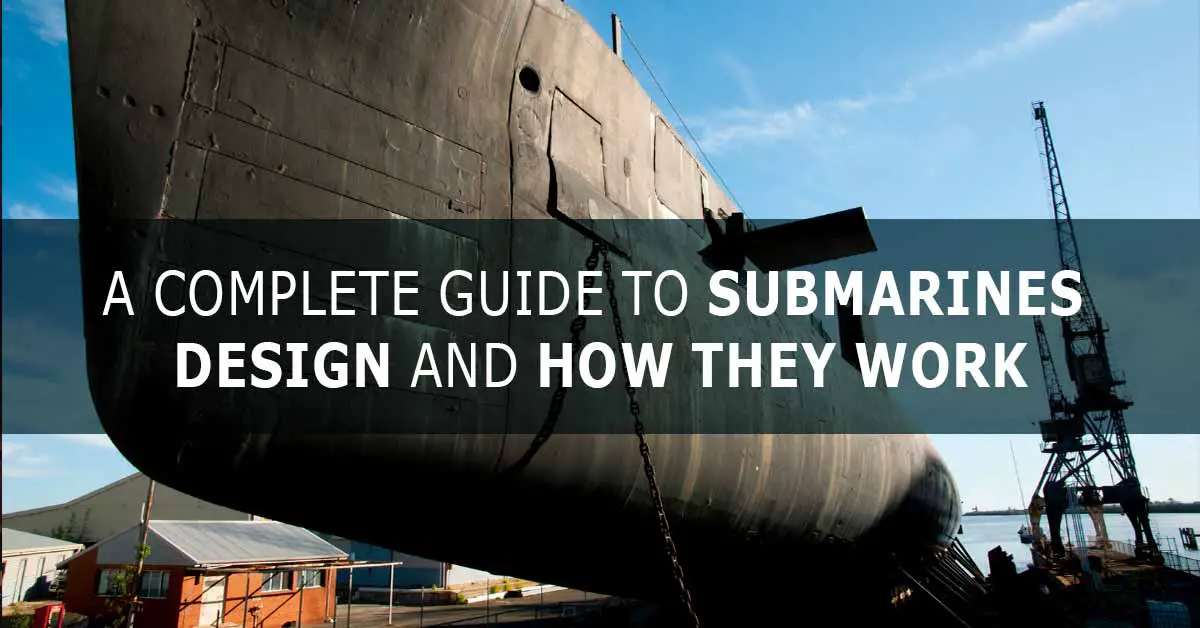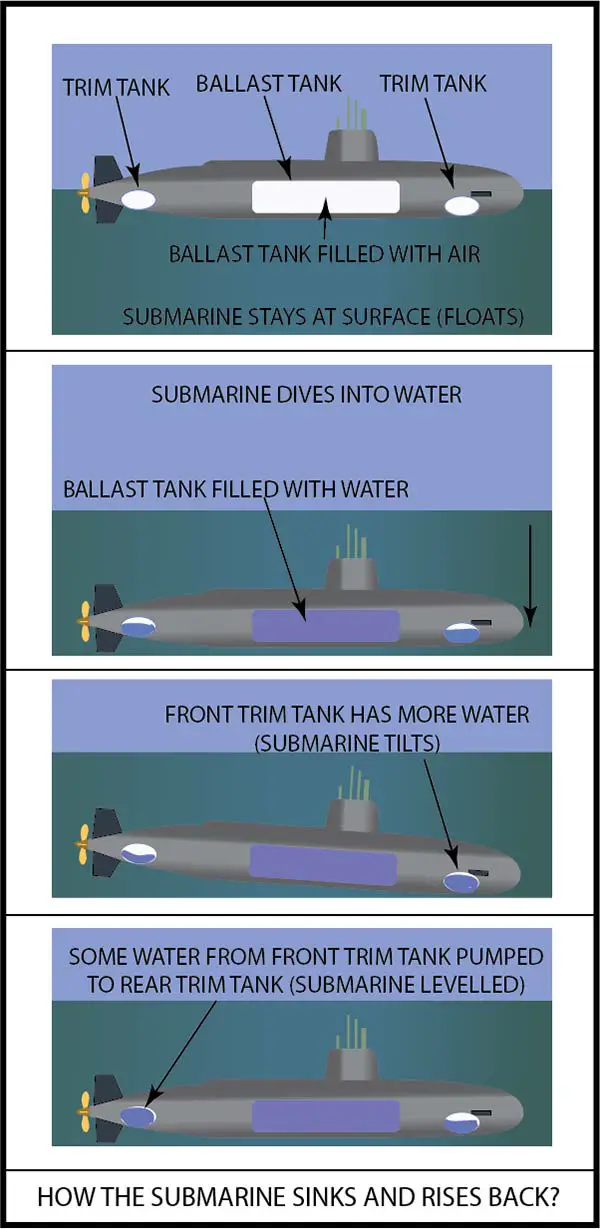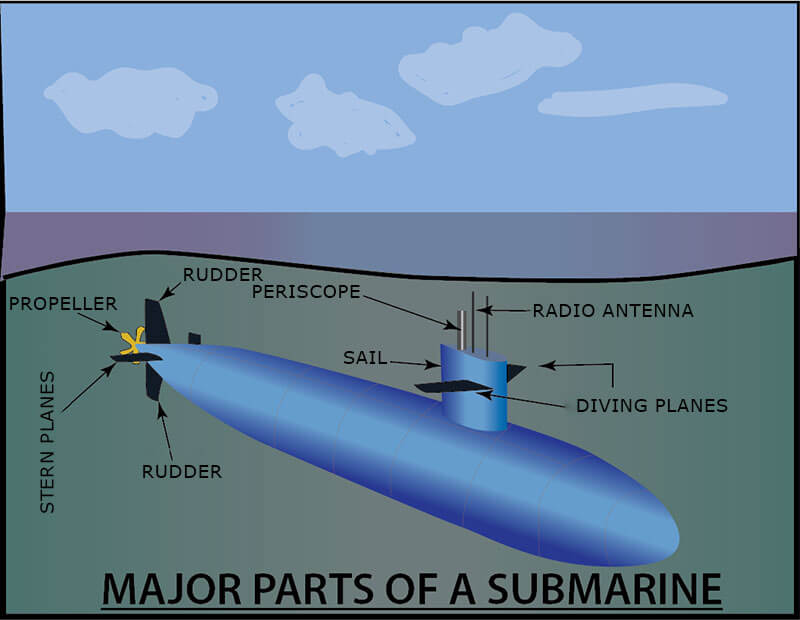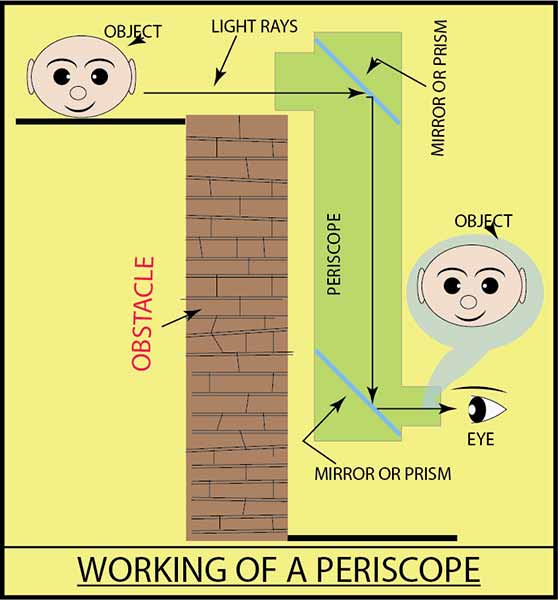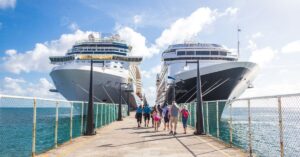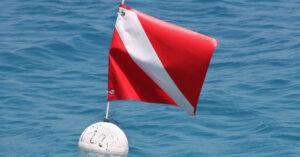Usually, the common public always wonders how a submarine weighing so heavy can do the magic of going down the sea and returning to the surface again. This article answers many similar questions on a submarine.
The article will take you through the different subtopics on submarines such as: what is a submarine, how a submarine works, what are the different designs of submarines, what are the types of submarines, what are the classes of submarines, what are the most common propulsion systems used on submarines, what is a nuclear submarine, communication and navigation system, and some frequently asked questions related to submarines.
What is a submarine? How submarine works?
As it is called, a submarine or sub is a type of warship or vessel that is designed to function independently when submerged under the sea for long periods. Even though most of the submarines are warships, there are few submarines used for other purposes. The potential of submarines is distinct from other warships, and they are different in their design and appearance.
A single submarine like the OHIO class of the USA can carry a huge amount of firepower that can be destructive and disastrous. The unique character of the present-day modern submarine is that they move quietly and can appear anywhere to strike the enemy. Submarines are known by different names. In Germany, it is called U-Boot or under-sea boat, Russia calls it an underwater boat, the USA calls it USS (United States Ship) Submarine, etc.
A strong nation wants to show its war powers like an aircraft carrier to the world so that its enemies are beware of it. However, when it comes to submarines, they normally operate unseen. The depth to which a submarine can dive is normally not published by any country. However, a large submarine powered by nuclear energy is known to operate at a depth of 800 feet (250 meters). In reality, however, the operative depth can be much more.
When we travel in a boat or ship, our main fear is fear of the boat or ship sinking or drowning. But if you consider a submarine, its main job is to sink into the depth of the sea and again appear on the surface when required. How a submarine does it?
How submarine float and sink?
Let us understand how a submarine goes deep into the sea and surfaces back.
A submarine has main ballast tanks and trim tanks. The ballast tanks help the submarine go down into the sea and come up to the surface. The trim tanks are used for keeping the submarine in balance. Each ballast tank has a hole at the bottom and a valve at the top.
When the valve is closed, the ballast tank is filled with air (air is trapped inside), the submarine is lighter than the water surrounding it, and hence it floats (like a ship). When the valve opens, seawater floods into the ballast tank drives the air out, and as the water fills the tank, the submarine becomes heavier than the surrounding water, and hence it sinks.
To get the submarine back to the surface, compressed air is pumped through the valve, the air displaces the water and fills into the tank, and the submarine rises to the surface. When the submarine is underwater, it can use the diving planes also for moving up and down.
The trim tanks are positioned in the front and rear of the submarine, and they are normally filled with water. There is an arrangement to pump the water from the rear trim tank to the front trim tank and vice versa. When the trim tank at the front becomes heavy, the submarine moves down, and to bring the balance back, the water from the front trim tank is pumped into the rear trim tank.
Managing a submarine
Each submarine will have two batches of crew members at any given time. For convenience, let us call them white crew and blue crew. The white crew will first operate the submarine on patrol, which may last 2.5 to 3 months. Countries that operate submarines will have many submarines, and they schedule them so that they will always have submarines underwater.
Serving on a submarine is tougher than serving on a surface ship. Due to this, submarines have a better budget for food stock, and good food is indeed a motivational factor for the crew, as no army can move on an empty stomach.
However, fresh stock of food cannot last more than 15 days, and after this period, only the canned, dried, and frozen food are available. A submarine powered by nuclear engineering can stay for a long time underwater; however, it has to come to the surface after 2.5 months since food stocked in the submarine does not last forever, and the crew members limit the stress they can take.
After the stipulated period (2.5 to 3 months), the white crew who are operating the submarine will take the submarine to a home port or to an overseas port of an allied country. The blue crew members arrive there, and both the white and blue crew work together to restock the food and essential items and restore the submarine. The blue crew members take over the submarine. The white crew members fly home or do as per the direction of their command. The submarine is attended for its maintenance. After the submarine becomes fit to sail with fresh food stock and other essentials, it will sail into deep water again.
The crew members (submariners) may have their days divided into parts. They will work for 8 hours on their assigned function, and the balance of 16 hours can be used for maintenance, dining, training, workout in the gym, sleep, etc. The crew spends 2.5 to 3 months in a submarine without the sight of sunlight. The eating place and the sleeping place (bunk) may be the only places where they do not work. Space is a luxury in a submarine, especially small ones.
In many small submarines, the number of crew is more than the number of bunks. The junior crewmembers share a bunk (one can sleep while the other is working his shift and vice versa). Submarines have places for the workout, but they are spread over in the available empty corners (not placed in one room).
Size of a submarine
Have you ever wondered about how big a submarine is? Many of you must have traveled in Boeing 747 that has a length of 70 meters. An OHIO class submarine of the US Navy has a length of 170 meters (2.5 times of Boing 747), and the diameter of a submarine is much bigger than a Boeing 747. There are submarines even bigger than OHIO class, such as the Typhoon class of Russia has a length of 175 meters, and its diameter is much bigger than OHIO class.
Design of submarines
The basic purpose of a submarine design is:
- Meet the functional requirements.
- Use the available resources for manufacturing the submarine.
- Manage expenditure within the budget and delivery time.
The space available in the submarine is used for various needs/purposes as mentioned below:
- Machinery
- Communication equipment and control room.
- Weapons, including torpedo tubes (with torpedoes in them), and torpedo launching system. This is located at the forward location of the submarine.
- Auxiliary machinery.
- Accommodation for the crew.
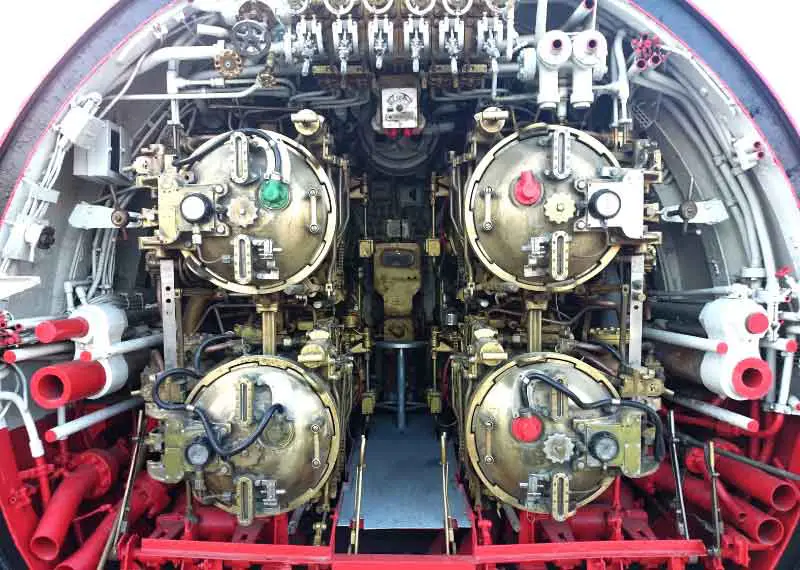
The external shape of the present-day submarines is a long cylindrical body in the middle and elliptical bow and stern. This is not an ideal shape from the design angle since it leads to additional fuel costs. However, the additional fuel cost incurred over the life period of a submarine is sufficiently compensated by the ease and economy of building the submarine.
Also, this shape gives more space, and it is easy to create multiple decks. The cross-section diameter of a submarine has a direct relation to the length of the submarine. Dividing the pressure hull volume into multiple decks improves the utilization of the hull volume. The number of decks that can be created depends on the diameter of the submarine.
Accordingly, a single deck will have two available levels (below and above deck level); in the same way, the design of the submarines can be a twin (two) deck, triple (three) deck, and four decks. Some spaces in a submarine, like ballast tanks, need to have a designed volume, there are spaces for battery packs that depend on the size of the batteries, and there can be many other spaces that depend on the units to be housed in it.
A designer has to compile data of all such possibilities before starting the submarine design. Also, unlike a ship, a submarine has to move both on the surface and under the sea. A designer must think of submarine stability as a design factor both when it is at the surface and under the sea.
Major parts and layout of a submarine
1. Submarine Hull
Present-day submarines are normally designed with two hulls, an outer hull and an inner pressure hull. The inner hull is designed to endure the high hydrostatic pressure that the submarine experience when moving in deep water; hence it is named pressure hull. The inner pressure hull accommodates communications and its control room, weapons and weapon control systems, battery packs, accommodation for crew, machinery, etc.
The pressure hull is inside the outer hull. The outer hull does not need to be pressure-tight because when the submarine is underwater, the space between the outer hull and the inner hull is used for ballast tanks and other tanks. When the submarine is submerged underwater, the ballast tanks are flooded with seawater, and hence there is negligible hydrostatic pressure on the outer shell. Submarines that need tough hulls have the hulls manufactured from tough steel/titanium.
2. Ballast tanks and trim tanks
There are spaces between the outer hull and the inner hull, and these spaces can be filled either with air or water. Part of these spaces is used as ballast tanks, and this, along with the diving planes, helps the submarine control its buoyancy (going up or diving down or floating). Apart from the ballast tanks, these spaces are used for many other tanks, including trim tanks. Ballast tanks help in the initial stages of diving into the sea or when returning to the surface from depths. The number of ballast tanks depends on the size of the submarine.
When a submarine performs emergency surfacing, all depth and trim methods are used simultaneously, together with propelling the boat upwards. Such surfacing is very quick, so the sub may even partially jump out of the water, potentially damaging submarine systems.
3. Bridge fin
The bridge fin has the shape of an aero-foil, and this acts as a hydrofoil when the submarine sails on the surface with the fins above water. The shape of the bridge fin eases the drag on the submarine.
4. Hydroplanes
The fins on the sharks’ bodies assist them in swimming and diving into the sea. Submarines have diving planes or hydroplanes, and it looks similar to fins. The diving planes have a slight comparison with the wings and its control features (swiveling flaps) of an aircraft that helps create an upward force (lift). The buoyancy or the upward force that keeps an object floating on water, and when the buoyancy becomes negative, the object sinks.
When the submarine is deep under the sea, it has negative buoyancy, and if left as it is, it will sink. However, when the submarine reaches the desired depth, its propellers push it forward, water moves fast over the diving planes. This creates an upward force called lift to help the submarine remain floating at the desired depth, and this state is termed neutral buoyancy or floating.
The diving planes have the facility of tilting to change the “lift,” which helps the submarine climb up or dive deep. Most of the time, the depth of the submarine is controlled using diving planes. The amount of lift generated by the submarine depends on the tilt angle of the planes and the speed of the submarine.
Hydroplanes are used for the control of rolling and pitching. The two hydroplanes on the aft are used to change the lateral (side) direction of the submarine when moving. These hydroplanes are also known as rudders. The efficiency of the hydroplanes is optimum at high speeds.
5. The propulsion compartment
The compartment containing the propulsion unit is at the aft of the inner (pressure) hull and has the main electric propulsion motor, its shaft, and related units. In a diesel submarine, the reduction gearbox is also placed in the propulsion compartment.
6. Tower/Sail
Submarines have a cigar shape (for smooth movement) with a tall tower in the center. In naval dialect, the tower is known as the sail. Submarine of earlier days used the sail for housing command and communications data center, periscope, radar, etc. In today’s submarines, most of these are shifted to the hull.
When the tower/sail is above the water surface in present-day submarines, it is used as an observation platform. When the submarine is underwater, the sail acts as a vertical stabilizer. The sail supports the diving planes in some submarine designs.
7. Life support systems (how submarines get oxygen?)
Huge military submarines will have many people working onboard, and they remain underwater at freezing temperatures for months together. How do they live?
A submarine is a completely sealed vessel. Today’s submarines are powered by nuclear engineering, and the nuclear reactor generates electricity. This electricity powers the complete support systems needed by the submarine and the people housed in it. There are units to generate oxygen and also to make drinking water from seawater.
The submarine carries sufficient food for its planned period underwater. The thrash produced is compacted, and there is a system to throw it onto the sea bed. The accommodation space is used for housing living and sleeping places, toilet modules, exercise and gyms, food stocks, etc., and is located in the middle of the submarine.
This location makes the access of both forward and aft easy for the staff, and since it is directly under the sail (tower), it gives an easy escape route in case of an emergency.
8. Control systems for the submarine and submarines’ weapons
The different systems of the submarine, including the weapon system, steering controls, navigational control system, diving planes, etc., are carried out from the communications and controlled room located in the middle of the submarine. Communications between the submarine crew and their naval command are carried out from here.
9. Battery bank or battery compartment
The diesel-electric submarines depend on the hydrogen cell batteries when underwater and these batteries are charged by diesel engine-powered generators (when the submarine is at the surface).
Normally a submarine has two battery banks placed in water-tight compartments, and each battery has sufficient energy to support the complete survival of the submarine. The presence of hydrogen in the battery compartment can lead to explosions. Hence it is important to have proper ventilation.
10. Machinery (main and auxiliary machinery)
The total weight of the main and auxiliary machinery can be around 30% of the total weight of the submarine. The main machinery includes diesel generators run by diesel engines, an air conditioning plant, and a high-pressure air system. The auxiliary machinery includes an auxiliary high-pressure system, an auxiliary electric motor, etc. The main machinery and auxiliary machinery are in different compartments.
11. Sensors
The submarine sensors are placed at the forward (in the space between the outer and inner/pressure hull) so that it is away from the turbulence and machinery sound at the aft.
What are the types and classes of submarines?
Submarines are normally used for military purposes by different countries. However, a few submarines are also used for other purposes like marine research and recreation purposes; however, these submarines are comparatively small and cannot go beyond a certain depth (marine research submarines may be capable of higher depths).
The submarines used by the military can be of the following types:
- Attack submarines.
- Ballistic missile submarines.
- Guided-missile submarines.
- Midget submarines.
- Special mission submarines.
One of the methods of classification of submarines is by their class. A class indicates details of the submarine, such as who is the builder of the submarine (country), the submarine’s displacement while in the sea (in tons of water), operating country, and the submarine’s physical dimensions. The class will also indicate the time of building (during world wars or cold wars).
Some of the world’s largest submarine classes are listed below:
- TYPHOON class – This is a nuclear-powered ballistic missile submarine built and operated by Russia, and with a submerged displacement of 48000 tons, TYPHOON class is the largest submarine. This submarine provides comfortable accommodation for its 160 crew members.
- BOREI class – This is a nuclear-powered ballistic missile submarine built and operated by Russia and has a submerged displacement of 24000 tons. This submarine provides comfortable accommodation for its 107 crew members.
- OHIO class – OHIO class is built and operated by the USA, and this includes both ballistic missile submarines and cruise missile submarines. With a submerged displacement of 18750 tons, OHIO class submarines are the largest built for the US Navy. This submarine can carry 24 Trident II missiles.
- VANGUARD class – VANGUARD class is a nuclear-powered ballistic missile submarine built and operated by the United Kingdom and has a submerged displacement of 15900 tons.
- TRIOMPHANT class – TRIOMPHANT class is a ballistic missile submarine built and operated by France and has a submerged displacement of 14335 tons.
- VIRGINIA class – VIRGINIA class is a nuclear-powered cruise missile attack submarine built and operated by the USA. This submarine has a submerged displacement of 7900 tons.
- COLUMBIA class – This is an upcoming nuclear class of submarine manufactured in the USA for the US Navy, and it was earlier known as an OHIO replacement submarine. It is scheduled for completion by 2031.
- LOS ANGELES class – This is a nuclear-powered fast attack submarine built and operated by the USA.
- ASTUTE class – This belongs to the latest class of nuclear-powered fleet submarines built and operated by the United Kingdom.
- AKULA class – This is a nuclear-powered attack submarine build and operated by Russia.
For more details, read our article: Top 10 World’s Largest Submarine Classes You Should Know.
What are the most common propulsion systems used on submarines?
When we go to the origin and developmental era of submarines, we come across submarines tried and tested with different propulsion systems, viz. propelled by human power, propelled by compressed air, steam engine using different sources of heat, internal combustion engine, hydrogen peroxide (for an air-independent system), etc.
However, the single problem all these propulsions faced was the non-availability of air when the submarine goes underwater, and these propulsions need air for combustion. Then came the submarines that run with electric motors powered by the batteries when underwater and runs with internal combustion (IC) engines when on the surface (air is available).
Various fuels like petrol, kerosene, and diesel were tried for the IC engine, and diesel is preferred due to its fuel efficiency and other qualities.
In the beginning, the IC engine, the electric motor, and the propeller were on the same shaft with a clutch between them (the IC engine followed by a clutch, followed by an electric motor, followed by a clutch, followed by the propeller).
When the submarine is at the surface or snorkeling (snorkeling indicates a submarine in shallow water and the IC engine gets the air for combustion from a breathing tube raised above water level), both the clutches are in the engaged position, the IC engine runs the propeller, and the electric motor works as a generator to charge the batteries. When the submarine is underwater, the clutch between the IC engine and the electric motor is disengaged, and the electric motor drives the propeller.
This system was modified later. In the modified system, the IC engine is coupled to a dedicated electric generator to generate electrical energy. This electrical energy is used to run the propeller through an electric motor and to charge the battery. In this system, the electric motor runs the propeller immaterial of whether the submarine is underwater or on the surface.
This technology has become a standard for all non-nuclear submarines and is popularly known as diesel-electric transmission. Many submarines use this system even today. However, the limitation is the battery’s capacity (the submarine can remain underwater only as long as the battery powers it). Some submarines run diesel engines when the submarine is underwater by burring diesel using liquid oxygen from cryogenic tanks. This is an air-independent system.
Advantages of the diesel-electric system:
- Less noise during the operation.
- The submarine can dive quickly since the only thing to do before diving is shutting down the diesel engine.
- The diesel-electric system makes the speed of the submarine and the speed of the diesel engine independent of each other. The diesel engine can be run to its best fuel efficiency even when the submarine moves slow.
- This system removes the clutches in the drive unit and hence saves space and maintenance costs.
- This system gives freedom of positioning the IC engine and other units since the IC engine, electric motor, and propeller need not be arranged in line now.
- A submarine with a diesel-electric system working on batteries is almost noiseless (the only sound is running of shaft bearings, propellers, and water splashing around the hull).
Disadvantages of a diesel-electric system:
- The IC engine in the earlier system was running both the electric motor (as a generator) and propeller, and in the diesel-electric system runs only the generator. Hence, fuel efficiency becomes less.
- In the earlier system, the electric motor was doing two functions (as a generator and as well as a motor). In the diesel-electric system, you need an electric motor as well as a dedicated generator. This leads to added cost and loss of additional space on the submarine.
Nuclear-powered submarines were introduced during the 1950s, and countries that have nuclear technology have gradually changed over to nuclear-powered submarines. This is discussed in the next section.
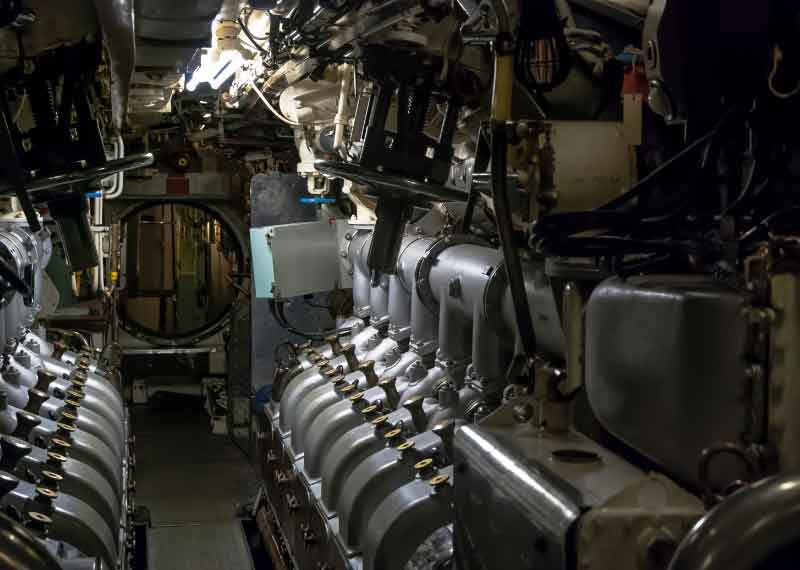
What is a nuclear submarine? What are its advantages? What are its drawbacks?
Steam power reappeared in the submarine during the 1950s when steam turbines powered by nuclear energy are used to drive the electric generator. The steam turbine replaces the diesel engine and hence becomes air independently.
Nuclear-powered submarines can sail submerged underwater for a long period, and the period is limited only by its food stock. The breathing air for the crew is recycled, and the freshwater is prepared using seawater. The important thing is a nuclear submarine practically has no limit on its range; it can go on and on at maximum speed.
With this capability, a nuclear submarine can travel from its base to the target zone quickly, and it is very difficult for anti-submarine weapons to track and attack a nuclear submarine. A nuclear-powered submarine has an arrangement of small battery and diesel engine/generator units for emergency use in the event of a failure of nuclear reactors.
Most of the larger-size submarines are powered by nuclear energy; however, due to the high cost and higher size of nuclear reactors, small and medium-size submarines still use diesel-electric propulsion. The countries owning and operating nuclear-powered submarines are limited since the countries having nuclear technology are limited.
Advantages of nuclear-powered submarines:
- Unlimited range.
- The nuclear reactor does not need air, and hence it is air independent. Electricity can be produced whether the submarine is at the surface or submerged deep under the sea.
- The nuclear-powered submarine is faster than a diesel-electric submarine. The nuclear-powered submarine can move fast when underwater and also can submerge and rise faster than a diesel-electric submarine.
- One nuclear power plant is sufficient for powering a submarine on the surface as well as when it is submerged.
- A small quantity of enriched uranium (nuclear fuel) will be sufficient for a long time.
Drawbacks of nuclear-powered submarines:
- One disadvantage of nuclear power submarines is noise. Nuclear power submarines make more noise since it operates coolant pumps and other machinery to run the reactor, however recent developments have reduced much of the noise made by nuclear submarines.
- Even minor accidents involving nuclear power submarines can be dangerous since there is the threat of nuclear radiation. Overexposure to nuclear radiation is seriously harmful to the crew working in the submarine, and it can even be fatal.
By the end of the 20th century, some submarines started using pump-jet propulsions. The propulsions are heavier, costlier, and have less efficiency than the regular submarine propeller, but they run much quieter. Quietness is an advantage for the submarine.
Advantage of a nuclear-powered submarine for attacking enemy targets
Consider an attack by a diesel-electric powered submarine. The submarine may need to come to the surface for attacking its target and again get submerged as quickly as possible to avoid being a target itself. However, such climbing up to the surface and getting submerged quickly may drain its battery power. Further, the speed of the diesel-electric submarine when underwater is much less compared to a nuclear-powered submarine.
One reason is the diesel-electric submarine cannot afford to drain its battery fast by increasing its speed. This drawback of the diesel-electric submarine limits its combat power, and it may not be able to attack a fast-moving battleship.
On the other hand, energy is not a problem for nuclear-powered submarines. A nuclear submarine can come to the surface, do the attack and submerge fast into the depth of the sea and vanish fast. It can do all these repeatedly, without worrying about draining its power, since it has abundant power for its fast movement.
Also, due to its fast underwater movement speed, it can chase any fast battleships. Presently, some major countries are not building diesel-electric submarines anymore. They find it expensive to maintain both types of submarines.
Communication and navigation system in a submarine
How submarines communicate?
Navy ships on the surface have phones, postal mail deliveries, and even the internet; however, when it comes to a submarine, the communication with the outside world is limited. Every crew in the submarine has an email address to which their family can send the message. Whenever the submarine is in a position to receive communications, such messages are sent to it electronically.
A designated crew member onboard the submarine goes through all such mails and holds any information they do not want the crew member to know. Any negative messages from their family that affect the morale of a crew are held back. Since the submarine commander has no way to get the crew member out of the submarine, the negative messages are held back till the end of their patrol period.
For submarines sailing deep under the ocean, communication with the outside world or their command is not easy. All radio waves, except VLF, are not able to pass through the saltwater. VLF (very low frequencies, 3 to 30 kHz.) can penetrate into the saltwater up to a depth of 20 meters.
Countries operating submarines have large VLF transmitters for communication with their submarines. The very low bandwidth of VLF is a major disadvantage, and it is not capable of transmitting real-time audio signals. The maximum a VLF can do is a text of 700 words per minute. When the submarines are in deep water, they have the facility of launching buoys (floating objects equipped with communication gadgets) to shallow depths to help receive VLF signals.
Another issue is that the submarines do not have large transmitters, and hence they cannot respond unless they rise to the shallow depths so that their antennas sticking out of the water. When the submarines are at shallow depth, they can quickly upload and download the information with the satellites.
How submarines Navigate?
Since light does not travel well through water, the deeper you go in the sea, the darker it gets. Due to this, the captains of the submarine cannot make out where they are going. Submarines have periscopes (periscope is an arrangement of the tube with mirrors or prisms to enable an observer to view objects that are otherwise not visible). Still, they are useful only when the submarine is at surface level or just beneath it.
The fact that the submarines, by the nature of their function, move secretly under the water makes its navigation a difficult task. GPS and Radar cannot be used underwater since they work on high-frequency waves that cannot penetrate seawater.
A submarine submerged underwater can use Sonar by generating a small sound and then listening or detecting when the sound is reflected to map out or know its surroundings. However, emitting a sound from the submarine makes it easy for other ships or submarines to find its location. Hence, it is risky to use active Sonar when the submarine is on a secret mission.
Passive Sonar is a set of precision hydrophones that are placed in a unit towed by the submarine, and the towed unit can be more than 200 to 500 feet away behind the submarine. A submarine will have both active and passive sonars. However, the towed unit (passive Sonar) does not work in shallow water.
Submarines use an inertia navigation system called accelerometers and gyroscopes. This system takes the reference of the last recorded accurate GPS position of a submarine and then traces the movements of the submarine relative to the earlier reference. However, as the last recorded GPS position becomes older, the accuracy of this system reduces. This technique can be used with the added help of the map.
Submarines may have radar equipment for detecting surface ships and aircraft. Periscopes are not normally used, except when a contact’s identity is to be verified. Submarines use space satellites to tell their location in the ocean. Nonmilitary submarines use active Sonar and viewing ports for their navigation.
The human eye cannot properly see the sunlight when the submarine is underwater; hence powerful lights with high intensity are used for illuminating the area to be viewed. Some modern-day submarines move so silently that they can conceal themselves from the detection by another submarine sailing only a few feet away. Such a situation can lead to a dangerous collision between them.
Frequently asked questions on submarines
How a submarine sinks into the sea and come back to the surface again?
A submarine has one or more ballast tanks. These tanks have a valve at the top and holes at the bottom. When the submarine is at the surface, the ballast tanks are filled with air. Hence the submarine is lighter than the surrounding water, and it floats (like a ship).
When the submarine needs to go down, the valve at the top of the ballast tank opens, the seawater floods the ballast tank and fills it driving the air away. Now the weight of the submarine is more than the water surrounding it; hence the submarine sinks.
When the submarine wants to come back to the surface, compressed air is pumped through the valve; the air fills the ballast tank driving the water away. As the air fills the ballast tank, the submarine slowly rises to the surface. When the submarine is submerged in water, the diving planes are also used for moving the submarine up or down.
What is the maximum depth a submarine can submerge in a sea?
Since the military uses submarines for defending their countries, information such as “how deep they can go” is kept as classified and not revealed to the public. However, it is generally known that a large submarine can submerge to 800 feet or more.
How long can a submarine stay continuously underwater?
Present-day submarines are of two types, the first type is diesel-electric, and the second type is nuclear powered.
Diesel-electric powered submarines depend on battery packs for all their electricity needs viz. for submarine propulsion, for producing oxygen, drinking water, living, etc.
Once the batteries are discharged, the submarine must come to the surface to run the diesel engine coupled generator and charge the battery. Hence the time the submarine can spend underwater depends on the battery capacity. Diesel-electric submarines may stay underwater for 1.5 to 2 months.
On the other hand, a nuclear-powered submarine has a nuclear reactor that runs a steam turbine coupled to the electric generator. The nuclear reactor does not need air; it can work on the surface of the sea and submerged undersea to generate and supply electricity. Hence, a nuclear-powered submarine can stay underwater as long as necessary.
The only limitation is the availability of food for its crew members. This submarine carries a food stock sufficient for 2 to 3 months and comes to the surface after 2.5 months for replenishment with a fresh stock of food and to attend to other things like maintenance issues and change of crew members.
Can the submarine captain see outside when the submarine is underwater?
The sunlight has very weak visibility for a person underwater, and this visibility becomes almost nil at higher depths. A military submarine does not have a window or a view hole. The submarine has a periscope which they can use for viewing when the submarine is at the surface or in shallow water. One end of the periscope is placed at the submarine tower.
What is a periscope?
A periscope is a set of tubes (you can assume a tube in the shape of “Z” and the height of “Z” is more) equipped with mirrors or prisms.
The observer uses a periscope to view things that are otherwise not visible. For example, an observer can sit in a submarine and using a periscope to view the object on the surface. Of course, this is possible only when one end of the periscope pipe is above the sea’s water level.
What is the speed of a submarine when it is underwater?
This is classified information and not made public. However, the underwater speed of a nuclear-powered submarine can be around 20 miles per hour.
Conclusion
Our discussion on several features of a submarine in this article clarifies that a submarine is a dangerous weapon and can cause destruction without revealing much of its identity. So, countries owning submarines with the latest technology have a definite advantage compared to those who do not have it.
References:

